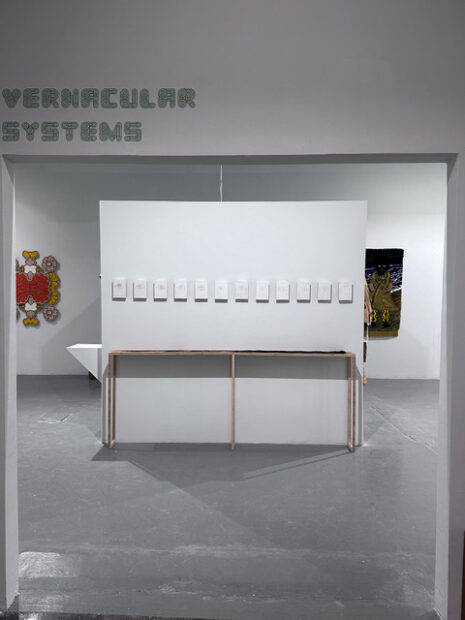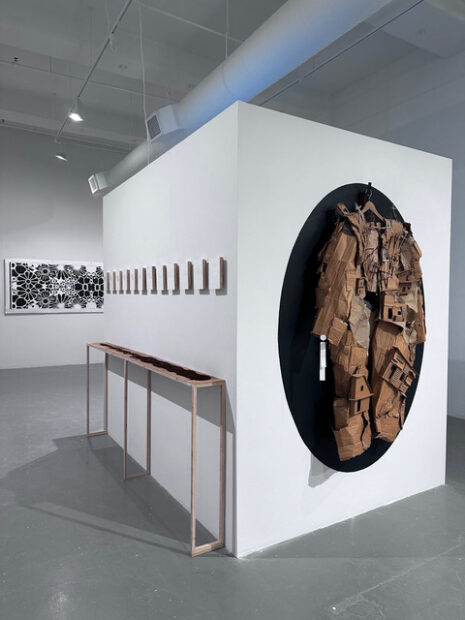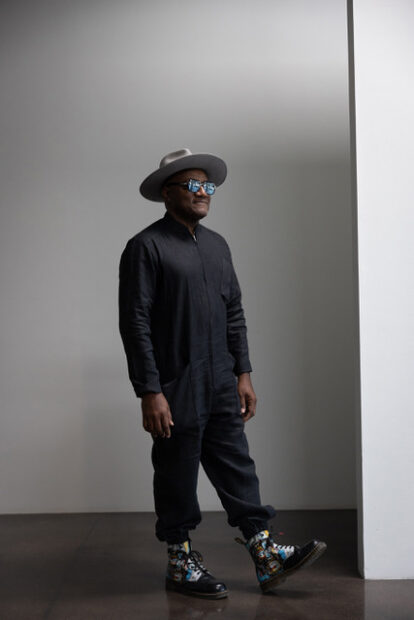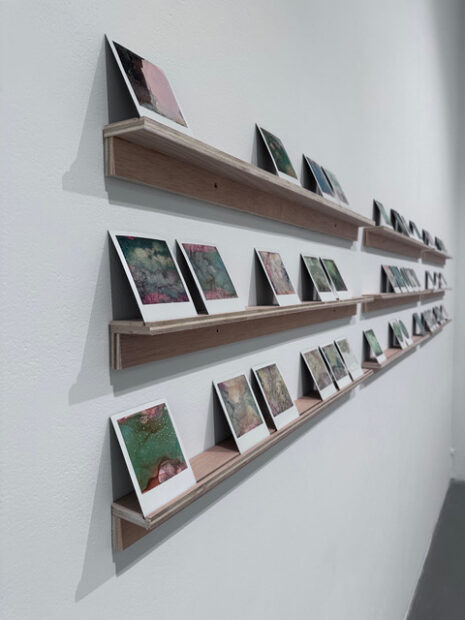The 2024 Contemporary Art Month Perennial Exhibition (CAM) showcases the work of twelve artists from San Antonio and Houston at the Contemporary at Blue Star. I had the opportunity to interview Christopher Blay, curator of the CAM Perennial Exhibition, one week before the show’s opening. Blay is also the Chief Curator of the Houston Museum of African American Culture in Houston, a visual artist that works with photography, video, sculpture, and performance, and a writer who was part of the Glasstire editorial team from 2019 to 2021. Prior to his tenure at Glasstire, Blay was curator of the Art Corridor Galleries at Tarrant County College.
I had a profound curiosity about how he navigates three disciplines as a creative: visual artist, writer, and curator. From our conversation, I learned about an artist who approaches art with a sense of devotion through each one of these channels, who has the understanding that it is a privilege to create something out of nothing.
We talked about the vast variety of techniques and narratives that artists in Texas are exploring, Blay’s approximations as a curator for this exhibition in particular, and his own work that explores the African experience in America as he reflects on the place of a creator.
Seyde Garcia (SG): How do you navigate the three areas that you juggle as a creator? Specifically the roles of the artist, curator, and writer.
Christopher Blay (CB): I don’t see a line between the things that I do. For instance, as a curator I do a lot of writing — I have to write. It’s my way of understanding the artist and the works that I’m dealing with, so it’s part of the job to write. It’s helpful that I did that anyway in my previous job as the News Editor and art critic at Glasstire, because it’s kind of the same process. You are looking at an artist’s work and trying to understand how the things they put together for an exhibition make sense, or even how the things they put together on one canvas, or photograph, or sculpture make sense together. I try to erase the lines between art and work and life. It makes sense to me that I use the ideas and concepts that I develop in writing to put together the things that I make as an artist, so it all kind of folds into each other.
SG: How did you approach the commission as curator of the 2024 CAM Perennial exhibition?
CB: First, I knew that I would be working with artists whose works may not relate to each other at all, and they would be artists living and working in Houston and San Antonio. So, two different cities, two different sorts of art worlds, if you could say that. I knew the theme must emerge based on the open call submissions and the actual artists selected. I didn’t want to go in thinking “I want to create an exhibition about connections.” I wanted to create an exhibition based on what I saw, and the themes that emerged from that.
SG: Did you have any expectations on what you would find through the submissions?
CB: My expectations were heightened when I realized who the artists were that were applying. I’m familiar with a lot of them because if you have been a curator and artist in Texas for a few years, you kind of know who the artists are that are making things, and who the galleries are as well. I was familiar with a lot of the artists that applied — there were close to 300 submissions — and a lot of them were artists that I always wanted to work with. There were also artists that I never heard of, and artists that blew me away when I started looking at their work. The expectations grew as I looked at the submissions, and as I narrowed down on the studio visits.
SG: Was there any particular thing that amazed you? Or that you didn’t imagine you would find?
CB: The variety of work, I think. All the painters are doing completely different and unique things. All the photographers are making different kinds of works. The sculptors have such a broad range of things, but yet, for the selection for this show, they all kind of fit together seamlessly, and that part of it was something I was very intentional about. But the surprising thing was the huge variety of work and the different modes that people were working in even if they were doing some of the same things.
Even for artists whose work kind of makes sense together, like Juan Carlos Escobedo and Alan Serna, who are both looking back on how connections to home and family relate, have completely different approaches. But when you are in the same room with both of their works, you see that connection almost immediately. You can’t necessarily place your finger on it, but these ideas start percolating and they are in the same atmosphere. Those are things that kind of emerge from these pairings and from some of these artists.

Entrance to the 2024 CAM Perennial exhibition, “Vernacular Systems,” on view at the Contemporary at Blue Star
SG: Is there a common narrative that you think artists in Texas are approaching right now?
CB: No. It’s such a variety. The variety is as big as Texas. There are a lot of artists working in collage, but when you put six collage artists together you will see such a wide breadth of techniques, approaches, and ideas. The same for painting; you can’t look at any painting in this show and say “yes, this is what Texas painters are doing.” Maybe the artists have a connection, but their styles and approaches are vastly different, and that’s what attracted me to the works of the artists in this show. They are all working with the very few systems that we have as artists: sculpture, painting, printmaking, photography, installation, and video. All the works within those modes are vastly different, but some of the themes that they’re thinking about — especially in the context of the place they’re living — might connect, but ultimately the work looks completely different and unique.
SG: How did you go about selecting the artists for the show and the work they contributed?
CB: It was difficult. It was probably the most difficult jury selection that I have had to do, because there are artists that I know, and artists that every Texan in the art world is familiar with, but whom I had to eliminate because the theme that was emerging didn’t connect with their work. And these are some artists that I would love to work with. Then, on the other side, there are artists who are still trying to find their voice and develop their techniques. When I looked at those artists’ work and went back to look at the artists whose work I selected, they didn’t feel compatible. It was a difficult process, but narrowing it down to about sixteen artists, then finally selecting twelve artists, was challenging, but it paid off because I think the artists in this show create a unifying theme, even though their works look very different from each other.
SG: How did you come up with the title Vernacular Systems?
CB: One of the artists, Zulma Vega, has an installation called Vernacular System, written singular. It relates to this idea of interconnectivity. In fact, I quoted her in one of the things that I wrote — it is something about “a profound and unseen network that binds us.” The title of the show comes from this idea. Thinking about her work and these connections to roots — hidden roots below the surface — and how the land is inseparable from the people, and how these bonds are permeating from examining things.
Take the coffee industry, for example. The beans and the bags travel around the globe, and attach to different parts of different economies and talk about different systems. Who profits? Who benefits? Who is hurt by these kinds of global systems? When I started thinking about those ideas, the theme that emerged was these connections, disconnections, and interconnectivity. Vernacular Systems, for me, is just like the current mode of working in community or an idea. Vernacular systems is how all these artists work in different modes but talk about this theme or interconnectivity. Once the works were selected I knew it was about interconnectivity and the loss of that.
SG: What is your sort of underlying philosophy or concept as a curator?
CB: I enjoy making art so much. I have a lot of friends who are artists, writers, and curators, and when I start thinking about art making and putting exhibitions together, and working with artists becomes a natural extension of extending that joy and that process. To me it is about doing what I like instinctively because I’m so connected to it. Sometimes the best experiences I have as an artist involve looking at art that is so much better than mine. When I look at it, I think “Oh my Gosh, I need to go back to the studio.” Or “Oh my gosh, I can’t believe they beat me to this idea,” or “this is so brilliant,” and I turned that into working with artists. I turned that into just kind of riding that wave of what these artists are doing so well, and trying to find a way to bring that same joy that I experienced looking at their work to people that come to see exhibitions I put together. I’m jealous as a curator because I love the work and the artists that I work with so much that I want to make sure that I can translate that joy and that experience to the people that come to see the shows.

Installation view of the 2024 CAM Perennial exhibition, “Vernacular Systems,” on view at the Contemporary at Blue Star
SG: Do you think it’s important that CAM builds these bridges between cities, like they have done in 2024?
CB: I think it’s important because while Texas is one of the largest states in the union, it’s also very compartmentalized and segmented. You have the Dallas-Fort Worth artists, you have the Houston artists, San Antonio artists, Austin artists. When we make connections and work together, we create this value in art and artists who are living and working in Texas. It’s kind of the same thing that happens in New York, LA, Miami, and Chicago. It’s like everyone is building their city as a place to go see and experience art, and because our cities are so far apart we end up doing things that kind of inform each other, but we don’t do as many things together as we could. We’re not the stereotype of how people view Texas, and if art can equally represent Texas the way that the news represents Texas, then I think it benefits all of us, because people would begin to see what Texas is truly about. It’s like this multifaceted thing. I think it was a great move by CAM to give the option to the curators to work across cities instead of saying it is only about San Antonio.
SG: My next question is about your work as an artist. Is there any theme that you are curious about right now?
CB: Yeah, I’m moving more internally than externally as an artist. I’m from Liberia, and there is a lot from Liberian culture that is obscure and hidden, even from my parents’ connection to that part of western Africa. My sort of focus right now, and my research which informs the current work, really looks into that mythology, that history, that culture, and finds ways of fusing it with African and American ideas, because I’m both things. It just makes sense for me to think about an all-encompassing nature of my heritage and my experience. So yeah, I’m looking a lot into Liberian culture, music, dances, mask making, art, architecture, language, food, aspirations, all the things.

Installation view of the 2024 CAM Perennial exhibition, “Vernacular Systems,” on view at the Contemporary at Blue Star. Left: Zulma Vega, “Impermanence,” 2023, screen print with coffee grounds on paper, coffee grounds, wood. Right: Juan Carlos Escobedo, “Papier Cartone Trench”
SG: In closing, I want to ask if there’s any advice you would like to give to a creator so they may find their true voice and to develop their technique.
CB: I think that answer is just the simplest answer that I can give, which is: make art that you are truly connected to. Make art that is honestly coming from you and not fully influenced by what other people are making or what other people want to see. Because if your focus is on being part of a trend, or being part of what’s hot right now, that changes every six months, so you will be left in the dust, or you’ll be trying to make something that looks like the things that people want to see and it’s hard to sustain that. If you’re making something that you are truly connected to, people might not understand it, or you might not make it to the exhibitions you want to be in, or it it might not be financially successful. But if you are an artist, you will get into it because this is something that we have — the unique position in society to create. To be a creator is a magical thing, because the things that come out into the world that are art start out as imagination, start out as this thing in somebody’s head, and then it becomes a physical thing; in that way, we are creators.
Vernacular Systems, the CAM Perennial exhibition, is on view at the Contemporary at Blue Star through Sunday, June 9, 2024 as part of the Contemporary Art Month (CAM), San Antonio programming and activities. Seyde Garcia is the third recipient of the annual Contemporary Art Month Writer’s Fellowship.




